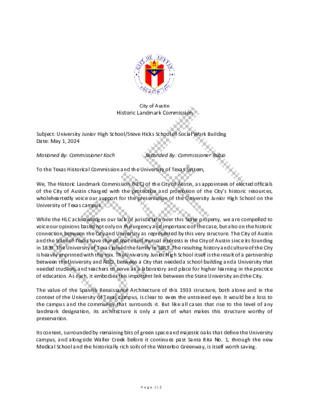DRAFT HLC Letter - University Junior High School — original pdf
Backup

City of Austin Historic Landmark Commission Seconded By: Commissioner Rubio Subject: University Junior High School/Steve Hicks School of Social Work Building Date: May 1, 2024 Motioned By: Commissioner Koch To the Texas Historical Commission and the University of Texas System, We, The Historic Landmark Commission (HLC) of the City of Austin, as appointees of elected officials of the City of Austin charged with the protection and promotion of the City’s historic resources, wholeheartedly voice our support for the preservation of the University Junior High School on the University of Texas campus. While the HLC acknowledges our lack of jurisdiction over this State property, we are compelled to voice our opinions based not only on the urgency and importance of the case, but also on the historic connection between the City and University as represented by this very structure. The City of Austin and the State of Texas have shared space and mutual interests in the City of Austin since its founding in 1839. The University of Texas joined the family in 1883. The resulting history and culture of the City is heavily imprinted with this mix. The University Junior High School itself is the result of a partnership between the University and AISD, between a City that needed a school building and a University that needed students and teachers to serve as a laboratory and place for higher learning in the practice of education. As such, it embodies this important link between the State University and the City. The value of the Spanish Renaissance Architecture of this 1933 structure, both alone and in the context of the University of Texas campus, is clear to even the untrained eye. It would be a loss to the campus and the community that surrounds it. But like all cases that rise to the level of any landmark designation, its architecture is only a part of what makes this structure worthy of preservation. Its context, surrounded by remaining bits of green space and majestic oaks that define the University campus, and alongside Waller Creek before it continues past Santa Rita No. 1, through the new Medical School and the historically rich soils of the Waterloo Greenway, is itself worth saving. P a g e 1 | 2 Its continued occupation by the school of Social Work continues to represent that unbroken thread of use by the University in one of its most humanistic areas of study, which is important to society and has generated many graduates who have served this City well. But perhaps its greatest value is as a symbol of the social progress forged through great effort in this city in the 1960s, as one of the first schools to desegregate. This having taken place on University land at the center of the City of Austin is a history worth honoring. While the University has long been hesitant to formally designate its properties under the various designation systems available, the System has long been a good steward of its historic properties. Surely the developments on the east side of campus offer other options for consideration to support the University’s football program, in an area already used for similar purposes. In the hundreds of hours we have attended in public hearings, we are keenly aware of the importance of hearing from the community to understand the degree of community support any given historic structure holds. The process has allowed for public voices to be heard in multiple venues, ultimately leading to the recommendation of the Antiquities Advisory Board of the Texas Historical Commission to recognize the historic importance of this State‐owned resource. This is democracy in action. We hope that the voicing of public support will encourage the University to reconsider this case, and the Texas Historical Commission to encourage that with a designation of the structure as a State Antiquities Landmark. Thank you, City of Austin Historic Landmark Commission P a g e 2 | 2